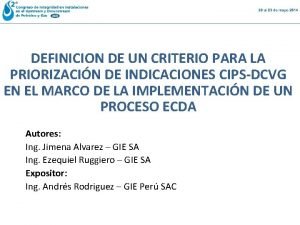CIPs Capital Improvement Plans CIPs Multiyear plans for











- Slides: 11

CIPs Capital Improvement Plans

CIPs Multi-year plans for major equipment, development, repair, and acquisition expenditures of $5000 (varies by community) and up

Manhattan Park and Recreation Department’s CIP process Prepared by MPRD staff for Dr. Sid Stevenson n The CIP is a long range (often 5 years) planning tool for major expenses. It is similar to, but different than an operating budget which deals more with day to day expenses for a 1 year fiscal period. n It should be a reflection of the needs of a particular agency, department, unit or program

CIP = large capital expenditures n Typically it will include all major projects such as land facility development n equipment purchases n land acquisition n n for the planning period

What constitutes a capital expense? n Exact dollar amounts will vary by agency, but inclusion of items below $2000 will rapidly become cumbersome for the agency. n Manhattan currently uses a figure of $5000 and a useful life of at least 1 year. n Others may require the item to be at least $10, 000 and require a useful life of the planning period (5 yrs).

A good CIP includes: n Identification and prioritization of needs n Helps to ensure a consistent level of service n forces planning and foresight n maximizes efficient and effective use of allocated funds n it will help ensure successful competition with other interested parties (e. g. City Dept’s) for scarce dollars. n It is a continuos, dynamic process

Who is part of the planning process? n The citizens (constituents) n elected officials n relevant boards or committees n agency administrators n agency staff

The CIP process varies by community by typically includes the following elements: n Input n from citizens (surveys, public meetings, and other avenues) n Preparation by staff (identified needs and justification statements) n Approval n Adoption process - typically includes a public hearing or series of hearings as mandated by local ordinance

Funding sources for CIP n General Fund Property taxes (use varies widely but typically low for municipal park and recreation agencies) n Sales tax (if not dedicated) Special taxes (lottery -Colorado, liquor - KS, dedicated sales) Bonds n Revenue n General Obligation Enterprise funds Surplus Funds Trusts Grants Donations Special FUNDS of numerous types (e. g. Chickadee checkoff) n n n n n

Scope of responsibility n Divisional Level n Input is solicited from divisional crew members to determine operational needs. Requests at this level include equipment needs, facility improvements n Supervisory Level n The focus is on equipment and facility needs to maintain levels of service, modifications to accommodate proposed expansion of services and requirements to satisfy divisional goals n Administrative Level n requests here reflect the accumulation of their divisions, major land acquisitions, new facilities and infrastructure

CIP links City of Manhattan CIP Budget 2011





















